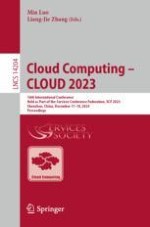2024 | Buch
Cloud Computing – CLOUD 2023
16th International Conference, Held as Part of the Services Conference Federation, SCF 2023, Shenzhen, China, December 17–18, 2023, Proceedings
herausgegeben von: Min Luo, Liang-Jie Zhang
Verlag: Springer Nature Switzerland
Buchreihe : Lecture Notes in Computer Science
